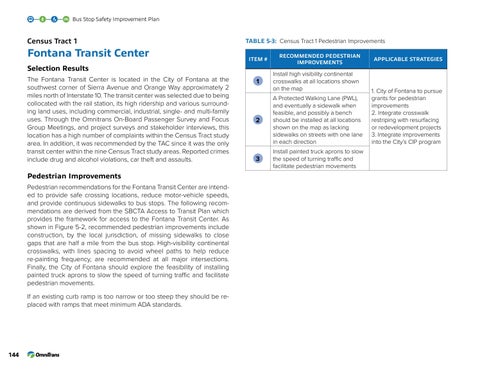Bus Stop Safety Improvement Plan
Census Tract 1
Fontana Transit Center
Table 5-3: Census Tract 1 Pedestrian Improvements ITEM #
Selection Results The Fontana Transit Center is located in the City of Fontana at the southwest corner of Sierra Avenue and Orange Way approximately 2 miles north of Interstate 10. The transit center was selected due to being collocated with the rail station, its high ridership and various surrounding land uses, including commercial, industrial, single- and multi-family uses. Through the Omnitrans On-Board Passenger Survey and Focus Group Meetings, and project surveys and stakeholder interviews, this location has a high number of complaints within the Census Tract study area. In addition, it was recommended by the TAC since it was the only transit center within the nine Census Tract study areas. Reported crimes include drug and alcohol violations, car theft and assaults.
Pedestrian Improvements Pedestrian recommendations for the Fontana Transit Center are intended to provide safe crossing locations, reduce motor-vehicle speeds, and provide continuous sidewalks to bus stops. The following recommendations are derived from the SBCTA Access to Transit Plan which provides the framework for access to the Fontana Transit Center. As shown in Figure 5-2, recommended pedestrian improvements include construction, by the local jurisdiction, of missing sidewalks to close gaps that are half a mile from the bus stop. High-visibility continental crosswalks, with lines spacing to avoid wheel paths to help reduce re-painting frequency, are recommended at all major intersections. Finally, the City of Fontana should explore the feasibility of installing painted truck aprons to slow the speed of turning traffic and facilitate pedestrian movements. If an existing curb ramp is too narrow or too steep they should be replaced with ramps that meet minimum ADA standards.
144
RECOMMENDED PEDESTRIAN IMPROVEMENTS
1
Install high visibility continental crosswalks at all locations shown on the map
2
A Protected Walking Lane (PWL), and eventually a sidewalk when feasible, and possibly a bench should be installed at all locations shown on the map as lacking sidewalks on streets with one lane in each direction
3
Install painted truck aprons to slow the speed of turning traffic and facilitate pedestrian movements
APPLICABLE STRATEGIES
1. City of Fontana to pursue grants for pedestrian improvements 2. Integrate crosswalk restriping with resurfacing or redevelopment projects 3. Integrate improvements into the City’s CIP program



















































